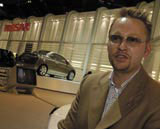Steering a cultural course
With the closure of Ingeni and the ascent of Nissan’s Rotunda, Christopher Kanal asks whether automotive design studios in central London have a future

British car design has fallen into flux. The sudden closure of Ford’s innovative design studio, Ingeni, last month is bringing about a shift in the landscape of the sector.
Ingeni shut its doors in December 2003, bringing to an end a project that promised something radically different, but which, like Icarus, aspired for too much and fell to earth.
Now, Nissan is hinting that it may consider offering design consultancy services to clients through its London studio, The Rotunda, in line with Ford’s model for Ingeni. If so it would take up the challenge of establishing an ambitious, truly multifaceted design studio in a cultural heartland, where Ingeni left off.
Ford insists design has not lost its importance, despite its decision to close Ingeni. ‘The reality is that the customer demands more and you have to respond to that change,’ says Dale Harrow, director of the Royal College of Art’s prestigious vehicle design course.
Ingeni was closed in a bid to redeploy Ford’s design assets in a tough economic climate (DW 4 December 2003). The move left its design director Gerry McGovern, the former director of design for Land Rover, in charge for just seven months. He replaced Henrik Fisker as head of the experimental studio in May 2003.
The brainchild of J Mays, Ford’s influential vice-president of design, the ambitious design centre opened in early 2002. Ingeni was created to try to rejuvenate Ford’s ailing brands through designing concept cars like the Faction, alongside more experimental work. Ingeni’s other projects included luxury car accessories and a variety of work for external clients in sectors such as telecoms and airlines. Could Ingeni have been a victim of its own ambition?
McGovern doesn’t think so. ‘There may have been a lack of understanding of what Ingeni was all about, but there was recognition that there were benefits to be had,’ he says.
It’s a different story at Nissan’s flourishing European design centre, The Rotunda, which opened in January 2003. Nissan chose London over other cutting edge design centres such as Berlin and Barcelona.
The Rotunda is home to approximately 20 car designers and is part of Nissan’s network of six worldwide design studios. Christopher Reitz is the studio’s chief designer, reporting to Satoru Tai, vice-president of Nissan Design Europe. Reitz believes Nissan has a strong future in the city: ‘London is the only truly international city in Europe. It is unique,’ he says.
Ingeni was based in the Richard Rogers-designed building in Soho ‘bang in the middle of a creative hub’, says McGovern. Harrow agrees that being in London is hugely advantageous to any car designer: ‘You can find out what drives the consumer. That doesn’t come from focus groups but from what’s happening on the street.’
McGovern says Ingeni’s closure was the result of a decision to re-evaluate Ford’s priorities. ‘It was a simple case of switching the wealth of the designers we have,’ he says. ‘The only way to do that is by redeploying and redispensing them within the company.’
The full story of why Ingeni closed may never be told, however. There is little way of telling whether Ford’s decision was made for financial necessity or because the idea was fatally flawed.
Harrow believes Nissan’s motives are different from Ford’s aims when Ingeni opened.
‘Nissan wanted to implant a serious design centre in a European cultural centre,’ he says. ‘Ingeni was a litmus paper for design trends and it was not connected with production work.’
He suggests that Nissan’s design policy is focused on a ‘total automotive response’ determined specifically to produce exciting car designs that will sell.
On the other hand, Ingeni was an experimental studio that worked on myriad projects of which automobile design was only a part. ‘Ingeni was a sponge to soak up the creative input from the location,’ says McGovern. ‘Was it a core constitute of the design business? It could have been.’
Harrow believes that in the past ‘the car business was about moulding metal. Now it’s about understanding cultural trends.’ What better way to understand ‘cultural trends’ than by being in the centre of London and in Nissan’s case, sponsoring a variety of design projects at the RCA?
And yet, Ingeni’s closure leaves questions, particularly over the viability of offering design consultancy services to outside clients. McGovern believes ‘Ford could not afford to have people of that calibre working on third party projects’, adding, ‘Design is tactical.’
For its part, the Rotunda does not work for third parties at the moment, but Reitz says that Nissan is ‘considering it’.
‘We would not be frightened of it,’ he says confidently. ‘Our sister studio NDA has done the same in California,’ he says, referring to Nissan Design America’s studio in San Diego, which sold design skills to outside clients.
And though Ford may have passed the design mantle to its Japanese rival, there might just be a return. McGovern, whose next post in Ford will be announced any day, believes there is a possibility of a return to Ingeni one day:
‘There is still a glint in one or two people’s eyes that say when the time is right we could do it again,’ he reveals.
Ford Faction
Ingeni designed the Ford Faction vehicle, which premiered at the 2003 Los Angeles Auto Show, for a congested urban environment. London naturally inspired it. The Faction concept is currently ‘on the shelf, like the other projects’. But the research will be used in the development of future cars. Gerry McGovern says concept cars don’t just define design direction, but are crucial to ‘help generate motivation in the industry’.
-
Post a comment



